Do we really need cutting edge technology to fight climate change? Some might say it’s obvious that innovation can bring us exciting solutions or useful tools. Others can blame the ecological crisis on technical or scientific progress. It’s up to everybody how they want to perceive this matter – there are no easy answers, however, it’s very likely that science and innovation might be the only way for us to survive.
How come? Well, there are many proofs that the newest solutions help us change our destructive habits. New biodegradable materials, solar panels, cultured meat, and hybrid engines – it’s all happening right now. We are living in the times of other revolutions and the only thing that limits us is our knowledge and desire to change.
You may wonder how we can evolve in terms of climate education. First of all, we need to find new ways of gaining knowledge and promoting it in order to spread the best behaviors and good examples. Yes, it’s a great responsibility, but every innovation will eventually become just a gimmick without proper education.
It’s exactly the point that was already made by Stanford University’s Virtual Human Interaction Lab. “Across four studies, two controlled lab experiments and two field studies, we tested the efficacy of immersive Virtual Reality (VR) as an education medium for teaching the consequences of climate change, particularly ocean acidification,” – says the study abstract. While reading into this paper, it’s actually very clear why universities and schools are more frequently deciding to test immersive media as a part of teaching courses.
(…) learning in VR is possible because VR systems produce highly engaging experiences, which can lead to a greater focus on the learning topic. VR puts users within a virtual learning environment that reflects the topic of interest (…), which can offer perspectives that are difficult to realize in other learning settings. VR can be effective for learning because it enables “users to interact with spatial representations” from many frames of reference.
– David M. Markowitz, Rob Laha, Brian P. Perone,
Roy D. Pea, and Jeremy N. Bailenson.
What’s the most promising about this particular piece is the conclusion that using immersive media is the right learning tool, effective across different age groups – high school students, college students, and adults. It shows that nearly everyone can benefit from the engaging experience that considers wildlife and environment protection. In the specific case of Stanford University’s VHIL team’s research, “the change in knowledge about ocean acidification was linked to increased engagement with and exploration of the virtual space.”
As you can see, it’s very natural for us – humans – to process information in a more careful way when it’s being represented in spatial and interactive form. We are simply experience-oriented learners, and VR technology is able to create the most comfortable environment for us to grow, especially when it comes to topics like climate education.
By creating Trash Rage – a recycling-learning experience in VR – our team has also taken a chance to prepare a valuable application that mixes environmental awareness with pure entertainment of being a part of active gameplay based on coordination and reflex. This product, is a great fit for the whole family, is however mainly dedicated to schools to enrich their lessons and additional courses.
Another example of raising ecological awareness through virtual reality is a widely acclaimed environmental project called IMMERSE, created by The Hydrous – a non-profit organization on a mission to create open access oceans. The 360-degree application is an audio-visual showcase of ocean beauty and biodiversity. By this project, its makers intended to create an effective and fascinating space to learn about the natural wonder of the water and the danger that it’s facing.
This and other projects show us how to engage and educate multiple generations in order to share the best ideas for preserving life on Earth. There is so much to do, and the newest technology helps us to make things right, gradually.

